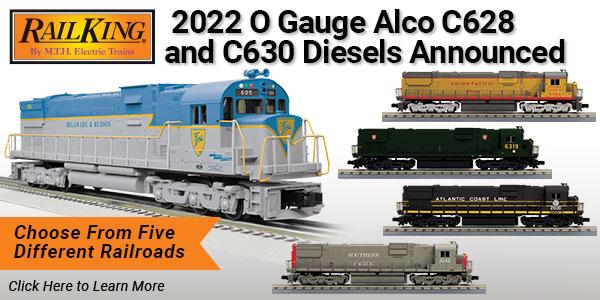
2022 RailKing O Gauge Alco C628/C630 Diesel Locomotives Announced
July 5, 2022 - M.T.H. Electric Trains will be releasing a series of RailKing O Gauge Alco C628/C630 Diesel Locomotives in five popular roadnames beginning this Winter. Each locomotive in these unique paint schemes will be outfitted with Proto-Sound 3.0 and will be available in very, very limited quantities beginning in January 2023.
PROTOTYPE HISTORY
The Century series was Alco’s last stand. Like Baldwin’s Sharknose diesels a decade before, the Century lineup, introduced in 1963, was a final attempt by one of America’s big three steam builders to stay relevant in the diesel market. Just three years earlier, former Alco partner General Electric had inaugurated the second generation of diesel power with its innovative U25B, and would soon usurp Alco as the number two firm in the locomotive business — a business dominated by an auto maker. With its back against the wall, Alco resorted to sheer muscle to try to win the day.
In the early 1960s, the generation of engines that had dieselized America was beginning to wear out. As manufacturers marketed second generation replacement power, one of their key selling points was “unit reduction” — replacement of lower-power first generation units with a smaller number of new, higher-power units. Compared with its 2500 hp rivals, GE’s U25 and EMD’s GP35, Alco’s C-628 (“Century series, 6-axle, 2800 hp”) was a beast — at least 30 tons heavier and nearly five feet longer than either of its competitors, and easily able to outpull them both. Alco’s claim that the C-628 was “the most powerful single-engine diesel locomotive ever built in the United States” was no idle boast. In an attempt to address dependability issues that had dogged earlier Alco diesels, Alco’s designers incorporated numerous reliablity improvements into the C-628 and its four-axle companions in the Century series — including pressurized air circulation in the engine room to keep out dirt (an idea pioneered on GE’s U-boats) and a claimed 8 years between major engine overhauls. Alco’s salesmen boasted that the C-series would cut operating costs by a whopping 44% versus a 10-year-old engine.
Unfortunately, however, the game had already been lost. With EMD having a firm grip on the market and GE coming up fast, the C-628, the best-selling model in the Century lineup, sold only 186 units from 1963-1968, compared with over 1300 GP35s and nearly 500 U25Bs. Most C-628 sales were to existing Alco customers, who were largely pleased with the engine’s 70 mph top speed and ability to haul tremendous loads. On roads with lighter track structure, however, the Alco’s tremendous weight and power proved damaging to the rails, hurting sales and causing some roads like the Monon to sell their units within a few years.
But in many cases, the rugged engines outlasted the company that built them and even the first railroads that owned them. The Pennsy’s C-628s were passed to the Penn Central and, along with the Lehigh Valley’s units, to Conrail in 1976, where they served another two years before retirement. And in 1973, the Chicago and North Western purchased the Norfolk and Western’s C-628 fleet and ran it for another 14 years. Alco, meanwhile, had shuttered its Schenectady locomotive plant in 1969 and sold its designs to its Canadian cousin, the Montreal Locomotive Works. After many changes in corporate ownership, Alco designs are still alive today in India, where a large number of diesels are driven by descendants of the same Alco 251 diesel motor that powered the Century series.
Check out each of the offerings below.





